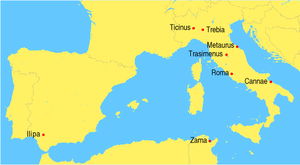Battle of Utica (204 BC)
| The Siege of Utica | |||||||
|---|---|---|---|---|---|---|---|
| Part of Second Punic War | |||||||
 | |||||||
| |||||||
| Belligerents | |||||||
| Roman Republic | Carthage | ||||||
| Commanders and leaders | |||||||
| Scipio Africanus | Hasdrubal Gisco, Syphax | ||||||
The Battle of Utica was a battle during the Second Punic War between the Roman Republic and Carthage. Roman General Scipio Africanus besieged Utica, but was overcome by the Carthaginian and Numidian forces under Hasdrubal Gisco and Numidian king Syphax respectively.
Having collected abundant booty and numerous slaves, in the autumn Scipio moved to Utica. His intention was to capture the ancient Phoenician city and make it a base for his further operations.[1][2] The direct assault on the walls was repulsed even though it was supported by siege engines and the Roman fleet, so that the Romans had to undertake a regular siege of the city.[3] The emergence of two large armies of the enemy effectively ended the siege very soon.[4] These were the forces of Hasdrubal Gisgo and his son-in-law Syphax, who apparently did not hesitate anymore. Their numerical superiority (according to the tradition passed by ancient authors such as Polybius and Livy, the army of Hasdrubal amounted to more than 30,000 and that of Syphax was twice as many,[1][5] but these numbers are considered as exaggerated by modern researchers[24]) forced Scipio to retreat to a promontory not far from Utica, which was later called Castra Cornelia. He fortified the narrow neck of land and set his winter quarters, relying on supplies of corn and clothing that were being sent to him from Sicily, Sardinia and Iberia. Hasdrubal and Syphax built their separate camps some distance from Castra Cornelia.[1][4][6]